Results 5,381 to 5,390 of 12095
Thread: Anandtech News
-
09-29-15, 06:00 PM #5381
Anandtech: Google Announces The Pixel C Tablet
In addition to the new Chromecast devices and new Nexus phones, Google gave the world a sneak preview of a new Android tablet which they call the Pixel C. Like the Chromebook Pixel, the Pixel C is designed completely in-house by Google, and it shares many attributes with the Chromebook Pixel even though it runs Android rather than Chrome OS. The hardware is also very interesting, and while there are many unknown details about the Pixel C, what is known looks promising.
As far as specifications go, the Pixel C has a 10.2" IPS display with a resolution of 2560x1800, which equates to a pixel density of 308ppi. Google states that the tablet's aspect ratio is the square root of two, and that's pretty much accurate as 2560/1800 is around 1.42. Representatives at the event stated that the display uses an LTPS backplane rather than an a-Si one, which allows for higher brightness and greater efficiency. Manufacturing LTPS displays at this size costs a considerable amount and it seems that Google felt it was necessary in order to achieve their 500 nit brightness.
As for color, Google advertises that the display covers the sRGB color gamut. I stated this in my live blog, but it's worth repeating that gamut coverage is only loosely correlated with color accuracy. The 2015 Chromebook Pixel covers the sRGB gamut, but is significantly less accurate than a laptop like the MacBook or the QHD+ XPS 13. Based on what I saw at the event, Google has put effort into making sure their new Nexus devices are well calibrated. However, they've also shown lacking effort in doing the same for their $1000 Pixel-branded laptop. I'm very interested to see how accurate the Pixel C's display is, and I'm hopeful that it can stand alongside the new Nexus smartphones and the Nexus 9 when color accuracy is considered.
Inside the Pixel C is NVIDIA's Tegra X1 SoC. Built on TSMC's 20nm process, the X1 packs a quartet of ARM Cortex A57 cores backed by 2MB of L2 cache, and another four A53 cores backed by 512KB of L2 cache, with NVIDIA balancing between performance and power efficiency. Meanwhile the GPU is a 256 core Maxwell implementation that should more than give other Android tablet SoCs more than a run for their money judging from what we've seen in other X1 devices.
It's hard to guess what we're dealing with in terms of clock speeds and TDP, as this is the first time that X1 has shown up in a mobile device. Ryan and Josh have done some previous analysis of X1, and so far the X1 has only been used in the SHIELD Android TV review, an Android TV console built to service 4K video playback and 1080p(ish) native gaming. Compared to the set-top Android TV, performance will obviously differ in a power and thermally constrained situation like a tablet - though by how much remains to be seen - and in any case the X1 remains as one of the most powerful Android tablet SoCs on the market at this time.
While launching the first Tegra X1 mobile device is quite a big announcement, the focus of the Pixel C is actually on the keyboard accessory that you can purchase for it. For Google, the Pixel line has always had a focus on providing users with great build quality, great keyboards, and great trackpads. The Pixel C is no exception, as it has a new bluetooth keyboard accessory designed to work specifically with it. While Apple and Microsoft have opted for soft keyboard covers, Google has decided to make their keyboard accessory out of the same aluminum as the tablet's chassis. This means that there really aren't any compromises as far as key feeling, size, and travel distance are concerned. The keyboard really looks and feels like a slightly condensed version of the Chromebook Pixel's keyboard, with only the lesser used keys around the edges being less than full size.
Almost as important as the keyboard itself is how it works with the tablet. Some devices use a kickstand, while others use the cover itself for support by folding. Google decided to come up with their own way, and when you see it in person you can't help but admire its elegance. The keyboard cover attaches to the tablet magnetically. You can store it on the front to make it like a folded laptop, or on the back when you just want to hide it. When it's on the back you can simply pull the tablet to one side, which shifts the magnetic connection and allows you to elevate the tablet and use it just like a laptop. It's really difficult to describe, but it works incredibly well and allows for a tilt range from 100 to 130 degrees without any sort of kickstand.
Since the keyboard connects via Bluetooth, it does need to be recharged. However, Google has come up with a method of doing so that is as elegant as the keyboard itself. While it's attached to the face of the tablet the small internal keyboard battery is charged inductively by the tablet itself. Having it in that position for only a few minutes a day allows it to stay charged perpetually, and the battery will last up to two months on a single charge. It's just a really ingenious solution and I'm really impressed by it.
The Pixel C is the next device in an emerging category of tablets that sit between your traditional tablet and traditional laptop. How users will respond is anyone's guess, but the Pixel C isn't priced at the extreme high end of the market like Chromebook Pixel is so it should be more accessible to consumers. On the subject of price, the Pixel C will start at $499 for 32GB, and $599 for 64GB, with the keyboard being a $149 accessory.
More...
-
09-29-15, 06:00 PM #5382
Anandtech: Google Announces Chromecast (2) & Chromecast Audio
Alongside today’s suite of Nexus phone announcements, Google also spent some time addressing the big screen with an update to the company’s family of Chromecast digital media player/receivers.
First off is the new, second generation Chromecast, which is simply being called the Chromecast. The update to Google’s original well-received player from 2013 doesn’t see a radical overhaul of the device, but does see Google making some significant changes where they need it most. On the networking side the Chromecast 2 has seen its WiFi radio upgraded from a single-band 2.4GHz 802.11n solution to a dual-band 2.4/5GHz 802.11ac solution, which should improve the overall bandwidth to the Chromecast while also making it a bit more apartment-friendly. Google’s presentation also notes that the Chromecast 2 uses multiple antennas to improve reception, presumably implementing antenna diversity.
Meanwhile Google is staying mum on the rest of the internal electronics, besides providing broad guidance that the Chromecast 2 still supports “1080p” video. Given that they have published the RAM – 512MB – it’s entirely possible that this is the same Marvell chipset. What we do know is that the display output is still limited to 1080p; the bigger question is whether H.264 video decoding is still limited to 1080p30, or if 1080p60 is finally supported.Google Chromecast Family Chromecast (1) Chromecast (2) Chromecast Audio Processor Marvell 88DE3005 SoC N/A N/A Memory 512MB 512MB N/A Wireless 2.4GHz 802.11n 2.4GHz/5GHz 802.11ac 2.4GHz/5GHz 802.11ac Display Output 1080p 1080p N/A Max Video Decode 1080p30 1080p N/A Ports HDMI
Micro-USB (Power)HDMI
Micro-USB (Power)3.5mm Combo Jack
(Analog + Optical Audio)
Micro-USB (Power)Launch Date 07/24/2013 09/29/2015 09/29/2015 Launch Price $35 $35 $35
The physical form factor of the Chromecast has also been overhauled, doing away with the stick form factor of the original Chromecast for a more stand-alone ball in the shape of the Google Chrome ball. The new form factor in turn now includes an integrated HDMI cable, which is designed to fold against the ball when not in use. The shift in form factors is apparently driven in part by Google wanting to improve WiFi reception in concert with the changes they made above. The change also removes the need for a separate HDMI extender for the Chromecast, which was previously necessary in some cases on the stick form factor in order to plug it in to an HDMI port in a tight space.
Alongside the Chromecast 2, Google also announced a second Chromecast product, the Chromecast Audio. True to its name, the similarly ball shaped device is to audio what the Chromecast 2 is to video, functioning as a digital audio player and receiver. The Chromecast Audio is designed to be an additional audio source to be fed into existing sound systems, offering 3.5mm, RCA, or optical audio out to a speaker/receiver.
Google is pitching the Chromecast Audio as a more elegant solution to home audio streaming than Bluetooth, in large part by avoiding the pairing/range needs of Bluetooth, avoiding the need to keep a phone awake to stream, and leveraging Google’s existing media casting infrastructure. Meanwhile unlike its visual counterpart, as part of Google’s social aspirations the receiver also supports receiving audio from guests, allowing anyone in the area to send audio to a Chromecast Audio.
Both the Chromecast 2 and Chromecast Audio are being released immediately in 17 countries, and will retail for $35 each, the same price as the previous generation Chromecast.
Finally, along with the release of the new Chromecast hardware, Google is also updating the Chromecast software. Notable new features include a new Chromecast app for both Android and iOS which offers a more centralized interface for both selecting which Chromecast receiver to work with, and for interfacing with Chromecast-capable apps. The new Chromecast app can list all of the installed applications on a device capable of casting, making it much easier to identify which apps one can cast from. Meanwhile the company is also rolling out a new “fast play” feature, which uses predictive loading to attempt to speed up the loading process by predicting what media the Chromecast thinks a user may access next, and then pre-loading the start of that media so that playback can begin immediately. Given the normal amount of time required to suitably buffer an H.264 stream to start playing it, this could significantly shave off loading times, though a big part of its effectiveness will depend on the accuracy of Google’s prediction system.
More...
-
09-29-15, 10:31 PM #5383
Anandtech: HP Announces New EliteBook Business Notebooks PCs with AMD PRO A-Series AP
HP’s Elite lineup is targeted towards business and professional users, and today HP is announcing a big refresh of the lineup. One interesting twist is that HP has partnered with AMD on these devices, and will be utilizing AMD PRO A-Series processors in both their desktops and notebooks. In addition to the other features of Carrizo such as HEVC decoding, the PRO lineup is AMD’s take on Intel’s vPro technology and should fit in well with HP’s goals with these machines.
There are three new notebook models with 12.5-inch, 14-inch, and 15-inch display sizes. The MIL-Spec tested notebooks will be offered with a wide range of options, but will be powered by the AMD A12, A10, or A8 APU models and 16 GB of memory. HP will be offering accessories like fingerprint readers and LTE as well. They also offer HP’s Sure Start BIOS which will automatically correct the BIOS if it finds there is an issue – whether malicious or not. HP will also be offering a choice of operating system from Windows 10 to Windows 7, and FreeDOS 2.0 as well. The displays are all SVA panels, with (unfortunately) 1366x768 as the base option on all three laptops, with 1920x1080 optional, or the 14-inch model can also be had with 2560x1440. On the networking side, HP has gone with Broadcom for Wi-Fi, and Qualcomm’s X5 LTE model is optional.
The notebooks have a nice magnesium chassis with a bit more flash than your traditional business PC. HP also includes spill-resistant keyboards, docking connectors, and RJ-45 on all models, and yes, even a VGA port which seems like it can’t ever go away.HP EliteBook EliteBook 725 G3 EliteBook 745 G3 EliteBook 755 G3 APU AMD PRO A12-8800B 2.1-3.4 GHz quad-core R7 GPU
AMD PRO A10-8700B 1.8-3.2 GHz quad-core R6 GPU
AMD PRO A8-8600B 1.6-3.0 GHz quad-core R6 GPUMemory 16GB DDR3L Display 12.5" 1366-768 SVA
1920x1080 optional
Touch optional on 1080p14.0" 1366-768 SVA
1920x1080 and 2560x1440 optional
Touch optional on 1080p15.6" 1366-768 SVA
1920x1080 optional
Touch optional on 1080pStorage 180-240 GB M.2 SSD
500GB-1TB SATA HDD128-512 GB M.2 SSD
up to 256 GB M.2 PCIe SSD
500GB-1TB SATA HDD128-512 GB M.2 SSD
up to 256 GB M.2 PCIe SSD
500GB-1TB SATA HDDI/O 1 x USB Type-C
1 x DisplayPort
1 x VGA
2 x USB 3.0
SDXC
RJ-45
Docking ConnectorDimensions (mm) : 311 x 219 x 18.9
(inches) : 12.2 x 8.6 x 0.74(mm) : 338 x 237 x 18.9
(inches) : 13.3 x 9.3 x 0.74(mm) : 383 x 258 x 19.4
(inches) : 15.1 x 10.1 x 0.76Weight 1.26 kg / 2.78 lbs 1.54 kg / 3.41 lbs 1.88 kg / 4.15 lbs Battery 44 Wh 46 Wh 46 Wh Price $749+
The new models should be available in September starting at $749.
Source: HP
More...
-
09-30-15, 07:33 AM #5384
Anandtech: The Corsair RM1000x and RM1000i 1000W Power Supply Review
Just over a year and a half ago we had our first encounter with Corsair's RM PSU series. The company upgraded their highly successful quiet PSU series and split it into two sub-series, the RMi and the RMx. Today we are having a look at the 1kW versions of the upgraded series, the RM1000i and the RM1000x, investigating their upgrades, performance and differences.
More...
-
09-30-15, 08:05 AM #5385
Anandtech: NVIDIA's GeForce NOW - GRID Cloud Gaming Service Goes the Subscription Way
NVIDIA's GRID game streaming service was launched back in 2013 as a beta project. Over the last couple of years, they have added a number of features that bring together the capabilities of their data center GPUs and their Tegra SoCs. At GDC 2015, NVIDIA indicated that they would be promoting the GRID program from beta to a commercial service. The commercial service was originally slated to launch along with the SHIELD Android TV in May, but the launch kept getting pushed back.
Today, NVIDIA is announcing that the service is getting out of beta with a new tag - GeForce NOW. With widespread and reliable Internet connectivity, content consumption is going the streaming way - services such as Netflix, Spotify and Hulu boast a huge subscriber base. NVIDIA is hoping that GeForce NOW will become the de-facto service for consumers looking to stream games.
Game streaming is quite challenging compared to traditional media streaming - in addition to low latency real-time encoding on the server side, we also need the client user input to have minimal lag while getting reflected on the server side. Companies such as OnLive and Gaikai have tried to address this market with mixed success (getting bought out by Sony in 2015 and 2012 respectively).
However, from our limited time over the past two years with the GRID beta service, we have to say that the experience can be quite compelling - the gaming experience is instant without having to wait for multi-gigabyte downloads, and one has a huge library of games to choose from (similar to Netflix's library of movies). NVIDIA has been pushing hard to keep latency within reason - generally aiming for the equivalent of a console game at 30fps - and while network quality and location are paramount here, reasonably low latency is attainable if you live close enough to one of NVIDIA's hosting facilities.
Moving on, NVIDIA believes that the other major advantage for their streaming service is that the rendering GPUs are in the data center and can be regularly upgraded. The end-user side just needs a dumb decoder and gaming controller - the SHIELD Android TV is quite future proof here, as it can easily decode 4Kp60 streams and has a GbE LAN connector - so only the hosting side would need to catch up. Currently, the GeForce NOW experience provides for game streaming at up to 1080p60 at 25 Mbps, while a 720p30 stream at less than 10 Mbps is also available for users with limited bandwidth. Similar to Netflix, NVIDIA uses adaptive bit-rate streaming that can scale the quality appropriately within the available bandwidth.
The initial focus of GeForce NOW is on the SHIELD Tablet and SHIELD Android TV. NVIDIA also has long-term plans to enable PCs as clients for the service.
As for the structure of the service, back in March NVIDIA announced that this would be a multi-tier basic/premium service. However as things have been finalized, NVIDIA has reduced that to a single tier of paid service, and there has been no talk of a basic or free service ala the current free beta. As such the GeForce NOW service will be priced at $8/month, with a 3-month free trial period starting after sign-up.
In terms of games, the catalog has been fairly consistent in the type of games NVIDIA is offering over the lifetime of the GRID beta, and it appears that this will continue to be the case for the paid service. This would mean that the games on the subscription service will largely be second-run games that have already been on the market for 6 months or more; the previous Batman game, the next-to-latest GRID game, etc, with 50 or so games to kick things off. In this sense GeForce NOW is very similar to the early days of Netflix, with the service acting as a way of accessing second-run content for cheap.
However NVIDIA is still bringing brand-new games to the service as well, and as previously announced back in March this will be through their Buy & Play program. Under Buy & Play, newer games that aren't available from the publisher for full subscription licensing can instead be purchased by individual customers for use with the streaming service, allowing customers to buy and immediately play these games on GeForce NOW. NVIDIA tells us that they will be rolling out new games under this program on a weekly basis, with the service launching with heavy hitters such as The Witcher III and Resident Evil: Revelations 2 available via Buy & Play on day one. However we should also note that based on NVIDIA's comments, it sounds like you must remain a subscriber in order to access the GeForce NOW service at all, so individual games picked up via Buy & Play would not be available if you discontinued your subscription.
Wrapping things up, NVIDIA has told us that GeForce NOW will be available in the US, Canada, Europe (incl. western Russia), Japan and South Korea starting today. The launch regions have been mainly dictated by the availability of data centers to serve the regions with minimal latency.
Finally, as part of the updates today, NVIDIA will also be more widely selling the SHIELD Android TV. In particular, Europe (UK, Germany, France and the Nordics) will finally be receiving the console, bringing the console beyond the American shores. Meanwhile in the US, we will start to see the STB available in brick and mortar stores such as Best Buy, Frys and Micro Center. And last but not least in a marketing promotion, Google Fiber outlets will also be promoting the SHIELD Android TV.
More...
-
09-30-15, 08:05 AM #5386
Anandtech: NVIDIA SHIELD Android TV OTA Update Improves HTPC Credentials
The NVIDIA SHIELD Android TV was launched back in May with the intent to dominate the over-the-top set-top-box (OTT STB) landscape. Premium features such as full HDMI 2.0a support and HEVC Main10 decoding enabled the coveted Netflix 4K certification. No other set top box (including the recently announced 2015 Apple TV and the Amazon 4K Fire TV) has anything close to the SHIELD Android TV in terms of advertised hardware and software capabilities. Our review, however, pointed out a few missed opportunities. Aside from the experience with Android TV as a software platform (something for which NVIDIA is not directly responsible), we had indicated that NVIDIA could have done a better job of codec licensing and configurability to cater to HTPC enthusiasts. Today, NVIDIA is announcing an OTA update to address some of those issues.
Today's OTA update (v2.0) brings a notable set of features for local media streaming
- Expanded codec and container support:
- Adds pass-through support for Dolby TrueHD and DTS-HD Master Audio lossless audio*
- Adds MPEG2, VC-1, and WMV9 hardware-acceleration
- Adds M2TS, ASF, and WMV container support for VC-1
- Adds WMA audio support (including WMA Pro, and WMA Lossless)
Currently, the above set of features are available for use in the native Android Video and Photo apps. NVIDIA is working closely with third-party app developers (including Kodi and MX Player) to ensure that these media players will also be able to take advantage of the newly added features.
The other important feature that is being made available is the ability to set the display refresh rate to 23.976 Hz. Currently, it is a static setting available under Settings > Device > HDMI > Resolution. Only 60 Hz (US) / 50 Hz (Europe) and 23.976 Hz are currently available, and the UI is also set to the selected refresh rate. However, NVIDIA expects third-party app developers to be able to dynamically alter the display refresh rate based on the content frame rate using the new APIs. This will be important since consumers should not be playing games or actually be navigating the user interface at 23.976 Hz. Syncing up the display refresh rate to the content frame rate should hopefully turn out to be a transparent exercise with the third-party apps.
The new firmware also brings support for overscan adjustment (particularly useful for display sinks that tend to overscan, resulting in a cropped view of the interface). Most TVs don't need this.
Other enhancements include native 4K rendering for select Android games (Beach Buggy Racing, Bombsquad, Hardwood Solitaire IV, Riptide GP 2, Kosmik Revenge, Video Poker Duel, Leo's Fortune, Machinarium, Meltdown, Never Alone, Samurai II, and Sky Gamblers: Storm Raiders), ability to transfer data between USB storage and a microSD card, ability to manually turn off the SHIELD controller and lowering the audio latency by as much as 40ms compared to standard Android. The last aspect is especially important for gaming, and it will be one of the prime reasons to pick up the update before checking out the GeForce NOW cloud game streaming service that is getting launched today.
NVIDIA has also updated the table comparing the SHIELD Android TV to the competition. The latest version is reproduced below. As usual, these are NVIDIA's claims and need to be taken with a pinch of salt.
We did go through the various aspects with concrete 'yes' or 'no' answers and the table seems to line up well with the actual specifications of the competitors' products. The SHIELD Android TV continues to justify the premium flagship tag despite recent entrants such as the 2015 Apple TV and the Amazon 4K Fire TV. NVIDIA's willingness to also focus on local media playback is good news for the general consumers as well as HTPC enthusiasts. For this reason alone, we can and do recommend the SHIELD Android TV over competing OTT STBs.
More...
- Expanded codec and container support:
-
10-01-15, 07:33 AM #5387
Anandtech: NVIDIA Announces Maxwell-Based Quadro M Mobile Series
By and large we erroneously tend to think of NVIDIA’s Quadro family of video cards as desktop video cards. While NVIDA has offered mobile Quadro cards for nearly a decade now, it’s largely the desktop versions that get all of the attention in the press, and this outcome is not unexpected. Professional CAD, CAM, and content creation have long been the domain of high-powered workstations, and while notebooks have since taken over the majority of the PC market, the transition in the professional space has been slower. Consequently the mobile Quadro family has not attracted nearly as much attention given the importance of desktop workstations.
As the last quarter of 2015 kicks off though, this is a situation that is changing for NVIDIA and workstations vendors as a whole. Intel announced their first mobile Xeon, the Xeon E3-1500M v5, marking Intel’s formalization of the mobile workstation market. And with Intel now more on-board than ever before, for vendors like NVIDIA this means that mobile workstations – though less powerful than their desktop counterparts – may not be playing second-fiddle to desktops much longer.
This brings us to today’s announcement from NVIDIA, the Quadro M Mobile series. After having updated the desktop Quadro lineup with new products based on Maxwell GPUs back in August, NVIIDA is starting off October by giving the mobile Quadro lineup the same Maxwell treatment. Altogether NVIDIA is launching six new Quadro M Mobile video cards, refreshing the entire lineup from top-to-bottom in a single go.
Overall this is a low-key launch for NVIDIA – there weren’t any full press briefings – but I suspect that for NVIDIA the launch of the latest generation of Quadro Mobile parts will be a big deal. The Maxwell architecture’s major gains in efficiency have helped all platforms, but no platform has been helped more than the power and heat dissipation limited mobile market, making mobile the form factor where Maxwell truly shines. As we’ve already seen in the consumer space over the past year, NVIDIA has been able to significantly increase their performance over the Kepler generation while staying within their regular TDPs, and this bodes well for NVIDIA’s Quadro Mobile lineup. NVIDIA is touting an up to 2x increase in performance, and as we’ve seen Maxwell should be able to come very close to that in many mobile workloads.
Taking a look at the individual cards, NVIDIA has opted to retain their traditional family-number-mobile naming scheme. This results in these new parts being the Quadro MxxxxM series, a bit of a mouthful of a product name.NVIDIA Quadro Mobile Specification Comparison (High-End) Quadro M5000M Quadro M4000M Quadro M3000M CUDA Cores 1536 1280 1024 Memory Clock 5GHz GDDR5 5GHz GDDR5 5GHz GDDR5 Memory Bus Width 256-bit 256-bit 256-bit VRAM 8GB 4GB 4GB FP64 1/32 1/32 1/32 TDP 100W 100W 75W GPU GM204 GM204 GM204 Architecture Maxwell 2 Maxwell 2 Maxwell 2
Digging deeper, the new Quadro parts can essentially be divided up into two groups of cards. The Quadro M3000M, M4000M, and M5000 are all based on NVIDIA’s GM204 GPU. The most powerful of these is roughly comparable to the GeForce GTX 980M, with 1536 CUDA cores enabled. It’s also the only SKU to get 8GB of VRAM, made possible through the use of the recent introduction of 8Gb GDDR5 memory chips. Meanwhile the 1280 and 1024 CUDA cores respectively is the M4000M and M3000M, which use further cut down GPUs and pair it up with 4GB of VRAM. Both the M5000M and M4000M are top-wattage 100W parts, while the M3000M brings that down to 75W.
At the other end of the spectrum we have the M600M, M1000M, and M2000M. As of press time NVIDIA has been unable to confirm which GPU is in these parts; based on the specifications it could be either GM206 or GM107, and there’s every reason to believe that NVIDIA is using the same GPU in all three parts. My bet is on GM206 so that there’s true feature parity with the rest of the Quadro M Mobile series, but we’re going to have to see what NVIDIA is able to confirm.NVIDIA Quadro Mobile Specification Comparison (Low-End) Quadro M2000M Quadro M1000M Quadro M600M CUDA Cores 640 512 384 Memory Clock 5GHz GDDR5 5GHz GDDR5 5GHz GDDR5 Memory Bus Width 128-bit 128-bit 128-bit VRAM 4GB 2GB 2GB FP64 1/32 1/32 1/32 TDP 55W 45W 30W GPU GM206? GM206? GM206? Architecture Maxwell 2? Maxwell 2? Maxwell 2?
In any case, these parts are the lower power, lower performance, and lower price members of the Quadro M Mobile family. The M2000M features 640 CUDA cores and 4GB of VRAM, while the M1000M drops to 512 CUDA cores and 2GB of VRAM, with the M600M bringing up the rear with just 384 CUDA cores and 2GB of VRAM. TDPs for these parts are 55W, 40W, and 30W respectively, which means these parts are going to be more practical for thin and light mobile workstations than the 100W heavy-hitters at the high-end of the family.
In regards of features, these parts will inherit the standard Maxwell family features, including Maxwell’s energy efficiency improvements and greater media encode/decode support. If all of these parts are GM20x-based as I suspect, then that means the whole family will also support hardware HEVC encoding, and for the M600M/M1000M/M2000M, hardware HEVC decoding, a first for a mobile Quadro product. NVIDIA has also confirmed that Optimus will be supported on all of these parts; otherwise in a direct-wired situation, each part can drive up to 4 displays, as opposed to 2 for the previous Kepler generation parts.
Finally, as the launch of the Quadro M Mobile series is timed to roughly coincide with the release of Intel’s Skylake processors, NVIDIA tells us that OEM availability will be similar. The parts will be rolling out over the rest of the quarter, with NVIDIA already securing design wins in Dell’s Precision 15 5000 series, Precision 15 and 17 7000 series, HP’s ZBook series, and the previously announced Lenovo ThinkPad P50 and P70.
More...
-
10-01-15, 08:33 AM #5388
Anandtech: Netgear Nighthawk X8 (R8500) Wave 2 802.11ac Router Set to Ship
Broadcom's XStream platform has enjoyed quite a bit of success in the Wi-Fi router market despite its high cost. The first generation XStream platform used a 3x3 configuration for each band, and lacked Wave 2 features such as MU-MIMO support or 160 MHz channels. At the 2015 CES, Broadcom updated their XStream product portfolio with the BCM4366, a 4x4 MU-MIMO capable radio that could work along with the BCM47094, a dual-core Cortex-A9-based network processor SoC. At the same time, D-Link also announced the DIR-895L AC5300 router based on that platform. Early last month, we also had Asus announcing the RT-AC5300U with the 4x4 tri-band XStream configuration. Unfortunately, none of these announcements came with a concrete ship date. Netgear was conspicuously silent about their plans with the new platform, even though they were the first vendor to come out with a product based on XStream Gen 1 - the Nighthawk X6 (R8000). Today, Netgear is announcing the Nighthawk X8 (R8500) based on the second generation XStream platform. Unlike the announcements from other vendors, the R8500 is available for purchase today.
As a recap, the tri-band Wave 2 XStream platform integrates two 4x4 5 GHz radios (at 2.1 Gbps each) and one 4x4 2.4 GHz radio (at 1 Gbps). The setup is capable of using 1024 QAM (Broadcom-proprietary NitroQAM, works only with clients having Broadcom Wi-Fi receiver chipsets) to boost performance. Most of the
Wi-Fi aspects have been covered in our D-Link and Asus router launch articles, and I won't go into detail here. Instead, the focus of this piece will be on the differentiating aspects in the Nighthawk X8.
The most striking aspect of the R8500 when compared to the other XStream Gen 2 routers is the presence of only four external antennae instead of eight. Netgear has opted to go for four external and four internal ones. Physical appearances aside, the four external antennae are all active ones. This is the first time that we are actually seeing active antennae being deployed - the Wi-Fi amplifiers are moved from their usual location in the router's motherboard to the top of the antennae. This reduces cross-talk on the board and also avoids signal loss in the transmission between the antennae and the board.
The other interesting feature is the availability of 6 LAN ports in addition to the WAN port (all GbE, obviously). Two of the 6 LAN ports come with 802.3addynamic link aggregation support in-built into the firmware. For select devices (such as certain ReadyNAS models), connecting both wired ports to ports on the device will automatically configure everything to take advantage of the teamed link. For example, it will be possible for two different wired clients or multiple Wi-Fi clients to stream out simultaneously from the NAS and get more than 1 Gbps of effective throughput from the NAS.
Like all other XStream Gen 2 products and Quantenna-based products, the MU-MIMO capability is present in the hardware, but the firmware to enable them will be made available later on. Netgear indicated it would be before the end of the year, but we wouldn't be surprised if it comes only after the Wi-Fi Alliance starts certifying MU-MIMO interoperability in 2016.
Other than the active antennae and link aggregation features, the R8500 comes with the standard value-adds that have been part of all the Nighthawk routers since the R7000 - beamforming, dynamic QoS (based on Broadcom's iQoS engine in the Broadcom-based routers and the Qualcomm Atheros StreamBoost engine in the Quantenna-based routers), VPN and DLNA support. All the XStream Gen 1 features in the R8000 (such as 'Smart Connect' to steer clients to the appropriate band) are carried over to the R8500. The router also comes with ReadyCLOUD USB Access, which enables secure access to any USB drive connected to the router over the Internet. Netgear also supplies ReadySHARE Vault, a PC program for backing up content to any USB drive attached to the router. Consumers loath to accessing a web UI to monitor / configure / repair their networks can also use the Netgear Genie app for this purpose.
The Nighthawk X8 R8500 AC5300 router is available for purchase today at an MSRP of $400.
More...
-
10-01-15, 08:33 AM #5389
Anandtech: Netgear's New ReadyNAS 21x Models Go Quad-Core
We had covered Netgear's ReadyNAS 200 series launch at the 2015 CES. Based on a dual-core ARM Cortex-A15 SoC designed by Annapurna Labs, the ReadyNAS RN202 (2-bay) and RN204 (4-bay) brought some advantages of the btrfs file system in a cost-effective manner to the SOHO / consumer market. We recently reviewed the Netgear RN202 and the unit performed reasonably well in our evaluation.
Today, Netgear is introducing two new models in the ReadyNAS 210 series, the 2-bay RN212 and 4-bay RN214. Both of these come with quad-core ARM Cortex-A15 SoCs (again, from Annapurna Labs). Other than the increased processing power with an updated SoC, the units are identical to the ones launched earlier this year. This means that the new units also have 2 GB of RAM, three USB 3.0 ports and one eSATA port. We have dual GbE links capable of link aggregation (802.3ad LACP), and Netgear indicated that the RN21x would have better performance with port trunking compared to the RN20x.
Focus is also on the software transcoding capabilities that come as part of the media server feature. The claim is that the quad-core platform allows real-time transcoding of 1080p content to lower bit-rates and resolutions (particularly for delivery over the Internet). The transcoding is still done in software, though. Netgear also has an anti-virus engine that allows inspection at line rates (resulting in minimal performance loss).
Performance claims for the ReadyNAS RN212 and RN214 point to 200 MBps reads and 160 MBps writes - not the best in the market, but in the top half of the scale when it comes to ARM-based units. As expected from any COTS NAS nowadays, the units come with a mobile app (Netgear ReadyCLOUD). The contents of the NAS can be securely accessed even from an external network using the app, thanks to the VPN tunnel that gets configured with minimal user input.
Netgear is launching the RN21x in tandem with the Nighthawk X8 R8500 router. The link aggregation capabilities of the NAS go well with the newly added capability on the router side. Multiple streams to/from the NAS should easily allow saturation of 1GbE clients as well as the 802.11ac Wi-Fi connections. Tech-savvy consumers can easily relate to the benefits of btrfs (bitrot protection and continuous snapshot protection). For the rest, the projection as a complement to the Nighthawk X8 AC5300 router will tend to boost visibility.
The diskless RN212 and RN214 models are available for purchase today, carrying MSRPs of $329 and $499 respectively.
More...
-
10-01-15, 01:00 PM #5390
Anandtech: AMD Updates Embedded Radeon GPU Line, Releases Radeon E8950, E8870, & E646
Given the long-term nature of AMD’s embedded graphics business, updates to the Embedded Radeon lineup of discrete video cards are fewer and farther between for AMD. But in turn these updates are more substantial for AMD. To that end, this week AMD is announcing the release of a trio of new Embedded Radeon discrete video cards, giving the entire Embedded Radeon lineup its first complete overhaul since 2011.
These products – essentially variants of AMD’s Mobile Radeon parts – are aimed towards non-traditional use cases where vendors need a mix of budget and powerful video cards for what are essentially sealed systems. Among the traditional use cases for these products have been digital signage, image processing/medical imaging, thin clients, and electronic (casino) gaming. The latter in particular is a particularly lucrative market for higher performance GPUs, as casinos increasingly invest in attractive, flashy games, and are competing with similar gaming experiences on mobile devices, which similarly are getting increasingly powerful.
The allure of the Embedded Radeon lineup for vendors, along with having hardware specifically tailored for this market – including features such as natively supported timing customizations – is the long term sales period AMD offers for their embedded products. Embedded Radeon parts are sold for 3 to 5 years, making them suitable for use in products with long production runs where manufacturers need to be able to source new components for an extended period of time.
Altogether AMD’s three new Embedded Radeon products are intended to cover the full range of the market, from high performance down to highly power efficient parts. Furthermore depending on the specific part, AMD offers hardware in three different form factors: PCI-Express (standard and half-height), MXM, and the company’s proprietary high-density soldered MCM form factor.
Starting from the top, the first new Embedded Radeon is the E8950MXM. As alluded to in the name, this product is only available as an MXM card, and is based on AMD’s Tonga GPU. This is a full shader enabled Tonga part with all 2048 SPs enabled and paired with 8GB of GDDR5 (using 8Gb chips), making it roughly analogous to the Radeon R9 M295X. In terms of power consumption the E8950MXM is rated for a 95W TDP.AMD Embedded Radeon Discrete Video Cards Radeon E8950 Radeon E8870 Radeon E6465 Stream Processors 2048 768 160 GPU Clock 750MHz 1000MHz 600MHz Memory Clock 6GHz GDDR5 6GHz GDDR5 3.2GHz GDDR5 Memory Bus Width 256-bit 128-bit 64-bit VRAM 8GB 4GB 2GB Displays 6 6 4 TDP 95W 75W 20W GPU Tonga Bonaire Caicos Architecture GCN 1.2 GCN 1.1 Northern Islands
As the fastest of the Embedded Radeons AMD is pitching this one as their ultra-high performance model, targeting a peak throughput of 3 TFLOPS. Unfortunately AMD’s specs are somewhat at odds with each other, so it’s not clear what this part is clocked at. AMD cites a 1000MHz GPU clockspeed, however the 3 TFLOPS peak number implies 750MHz. Given the 95W TDP, we’re going to assume for the moment that it’s the latter.
Finally as far as feature go, since this is a Tonga part it gets Tonga’s full feature set, including 4K H.264 decode, and like most Graphics Core Next products, the ability to drive up to 6 displays. Typical for the highest performance Embedded Radeon products, this is the only member of the updated Embedded Radeon family to ship with a 3 year sales window as opposed to 5 years on the other products.
Moving on we have the E8870, AMD’s high-performance model. Based on what appears to be a Bonaire GPU in product literature, this is a lower power video card targeting a lower performance segment. Here AMD is aiming for 1.5 TFLOPS peak, with the partially disabled Bonaire GPU running at 1000MHz and shipping with 768 SPs enabled. The E8870 has a lower 75W TDP and is available in both a MXM card and a full-height PCIe card, with both models shipping with 4GB of VRAM. Both models can also be used to drive up to 6 displays, although for the PCIe card there are only 4 physical outputs owing to the space required for the full size DisplayPorts.
Finally, the last of the new Embedded Radeons is essentially a carry-over from AMD’s earlier models, and that’s the E6465. Based on the company’s much older pre-GCN 40nm Caicos GPU, the E6465 is specifically targeted at budget and very low power markets with its 20W TDP. AMD offers the E6465 in all three form factors: an MXM card, a high-height PCIe card with 4 mini-DisplayPorts, and finally the soldered MCM package.
As the E6465 is derived from the previous E6460, the principle purpose in updating it has been to give it a significant upgrade in memory capacity and to reset the clock on availability. The E6465 makes the jump from 512MB to 2GB of VRAM, and meanwhile it gets a fresh 5 year availability cycle that will see it sold through 2020, almost a decade after the Caicos GPU first hit the market.
More...
Thread Information
Users Browsing this Thread
There are currently 22 users browsing this thread. (0 members and 22 guests)




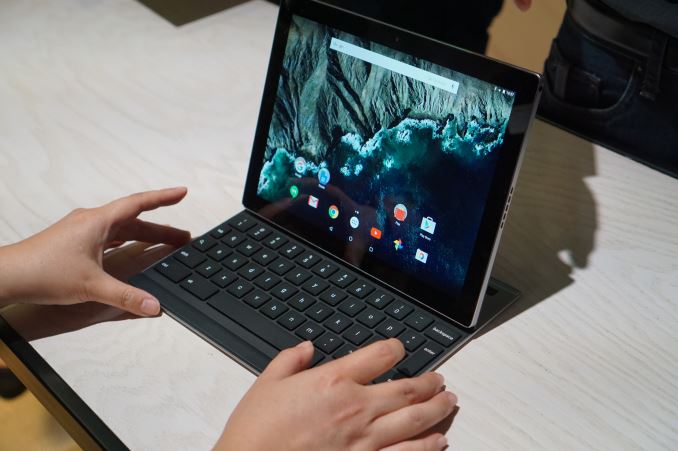
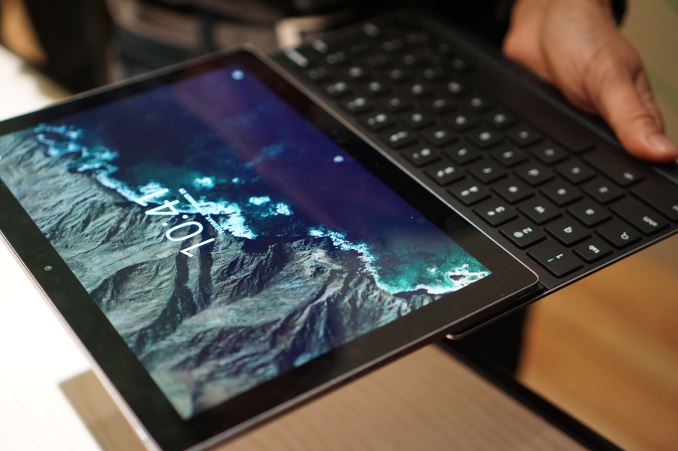
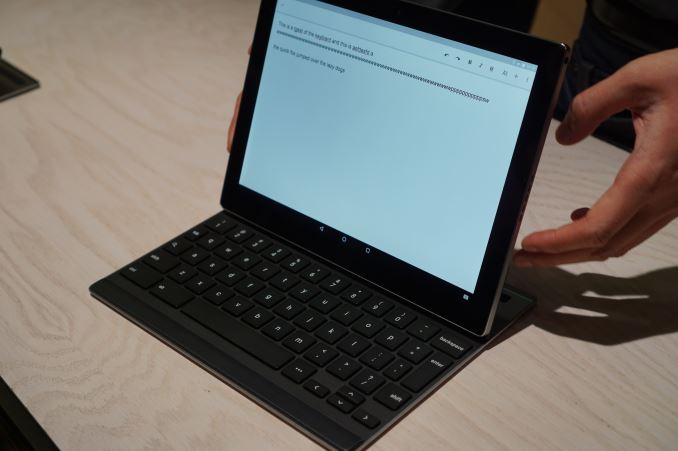








 Quote
Quote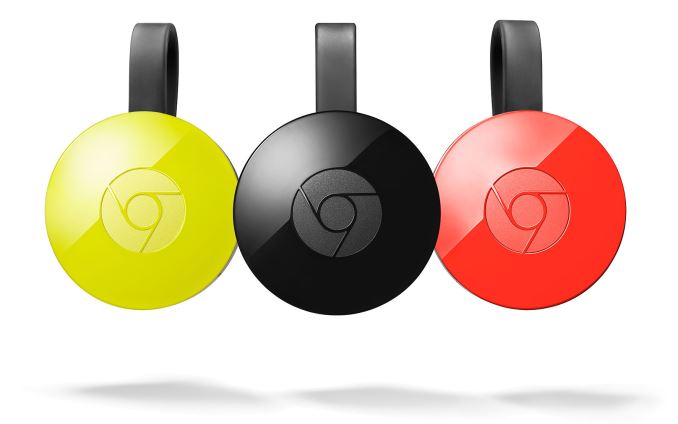
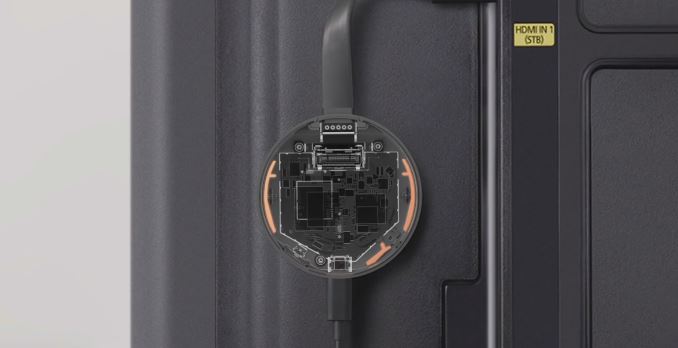
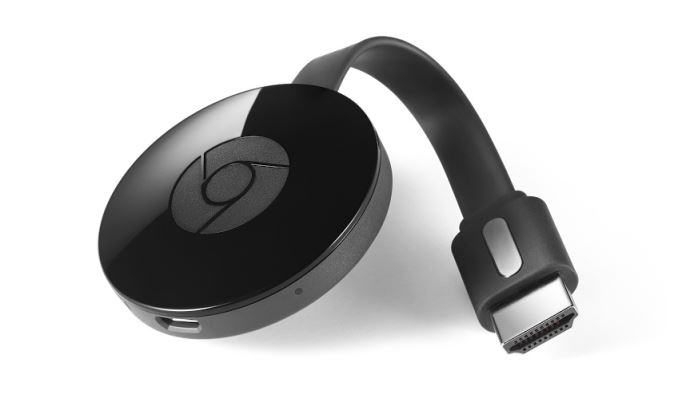
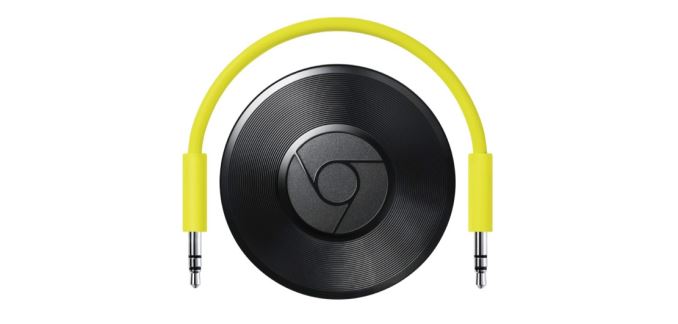
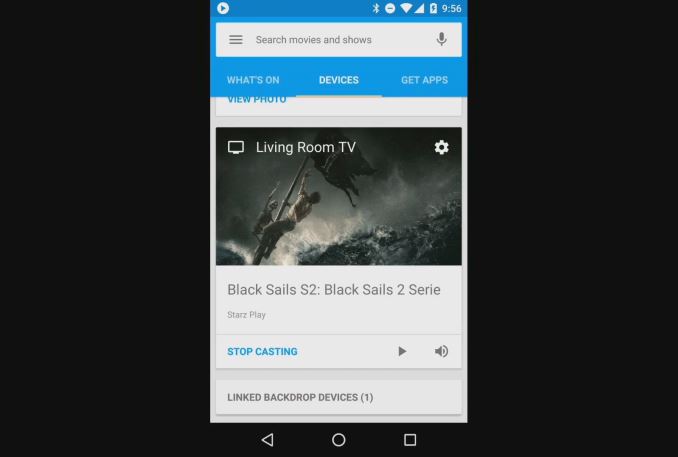

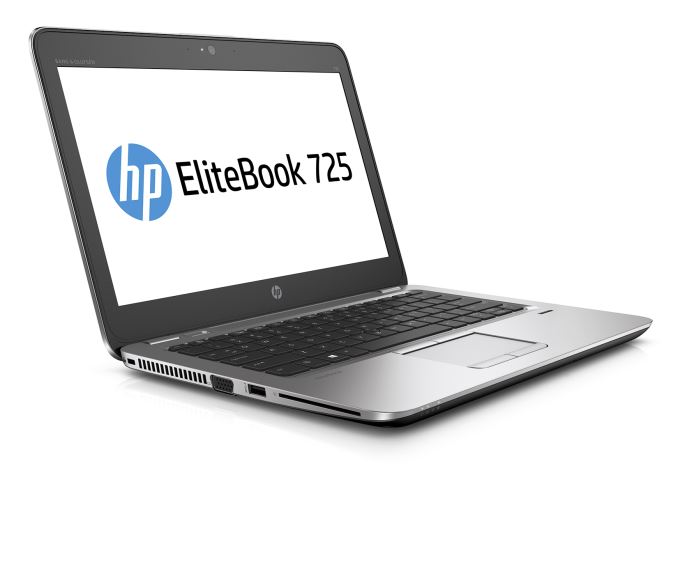
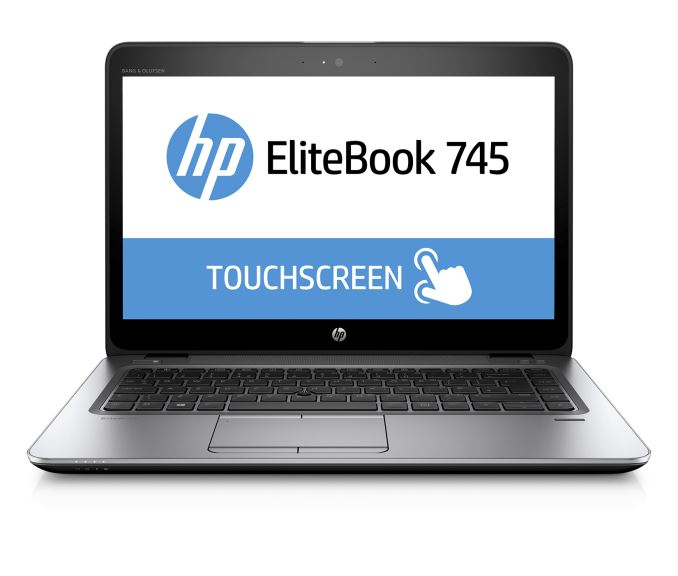
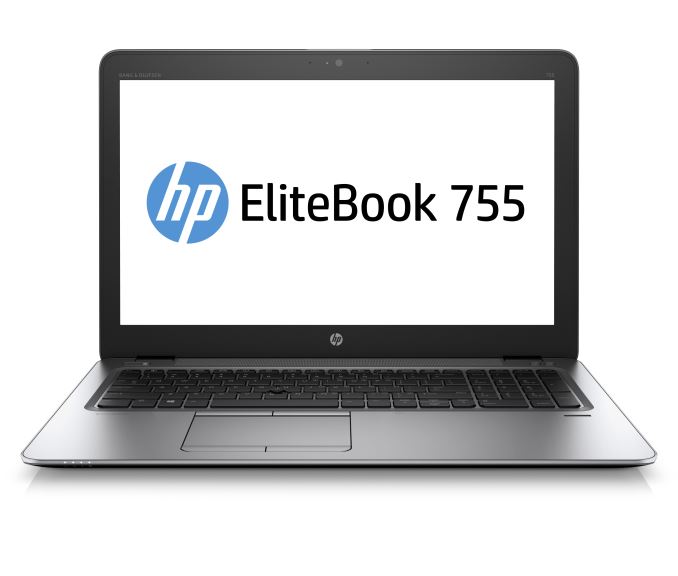
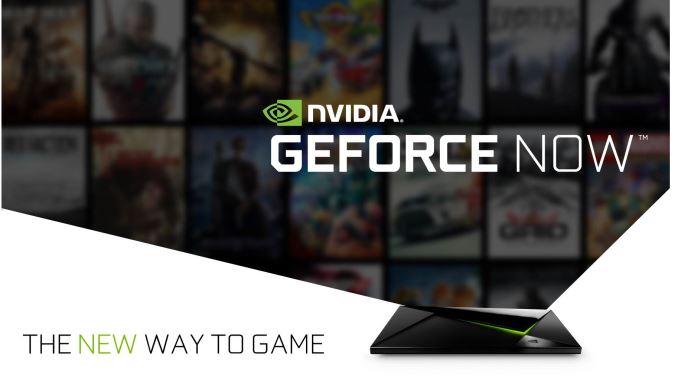
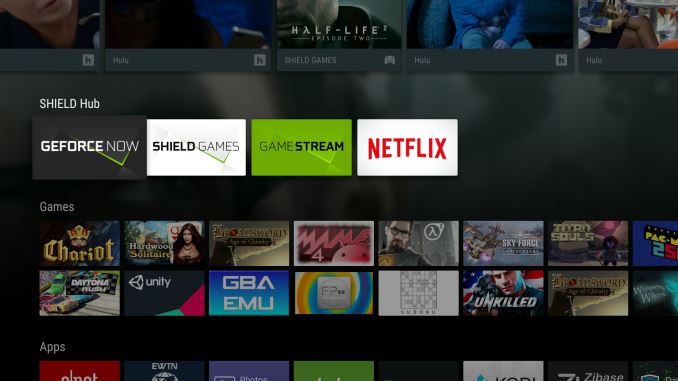
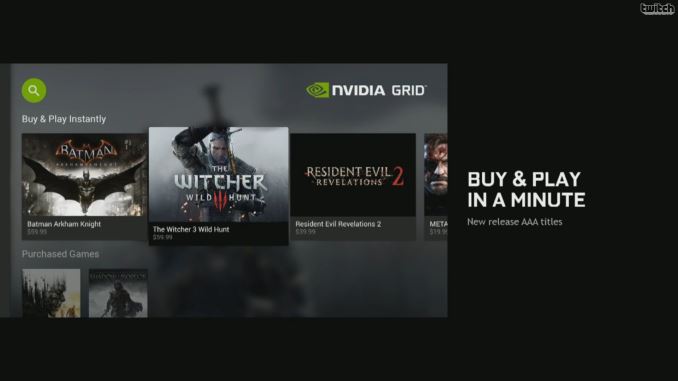
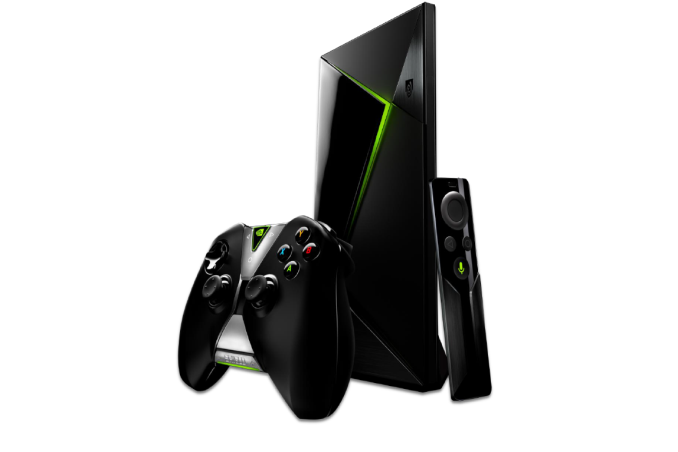
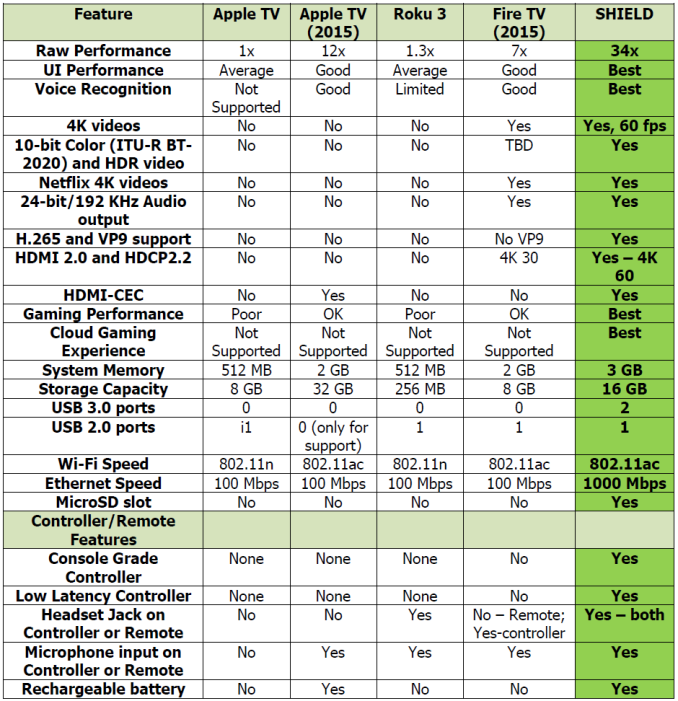
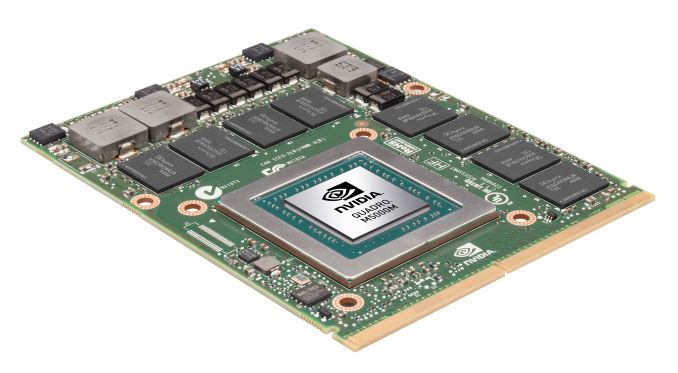
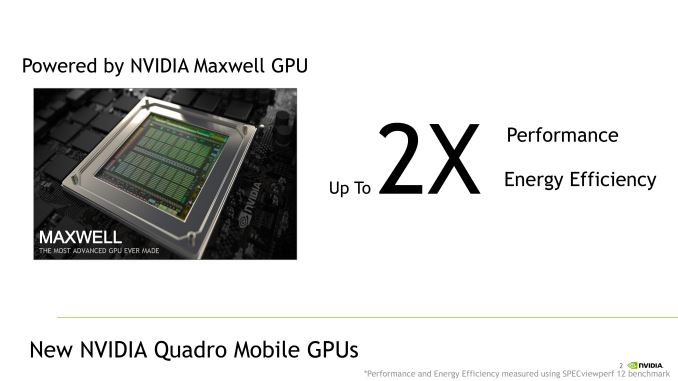
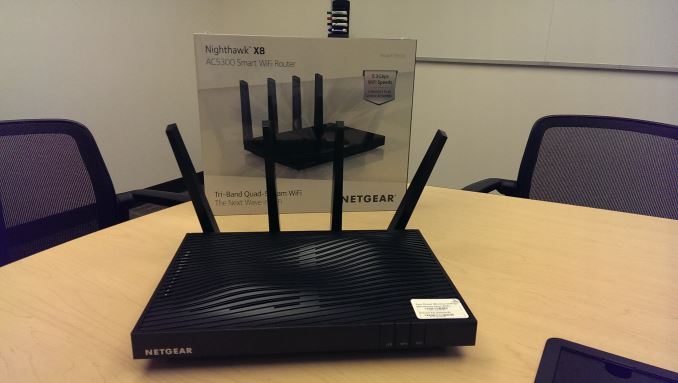
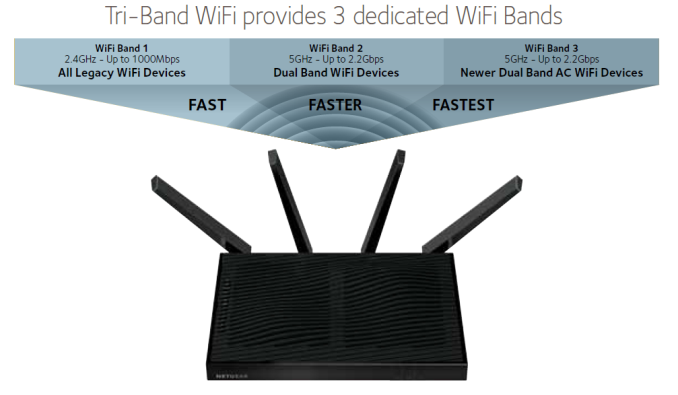
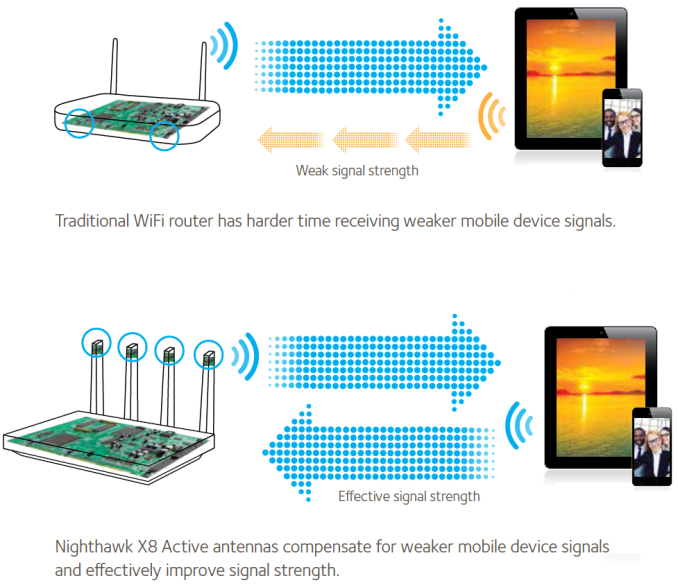
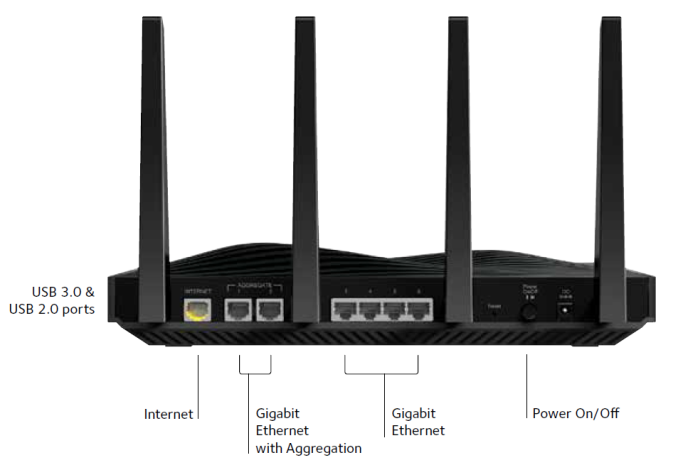
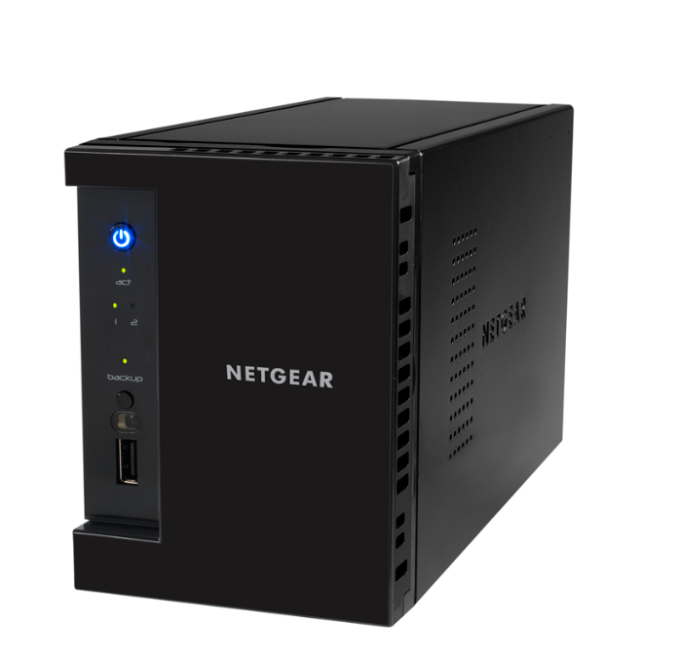
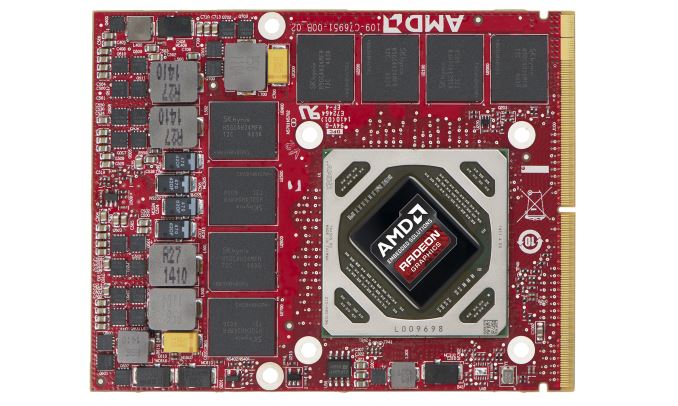
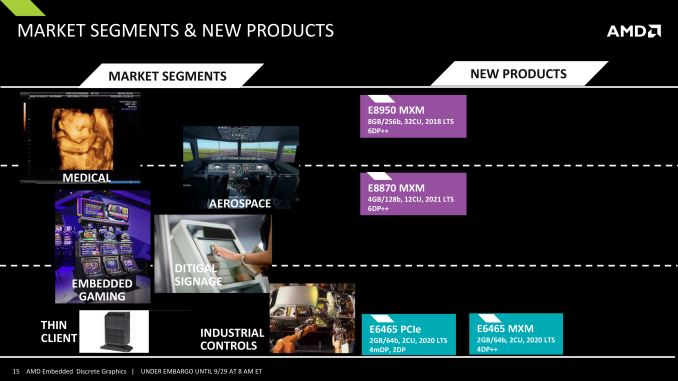
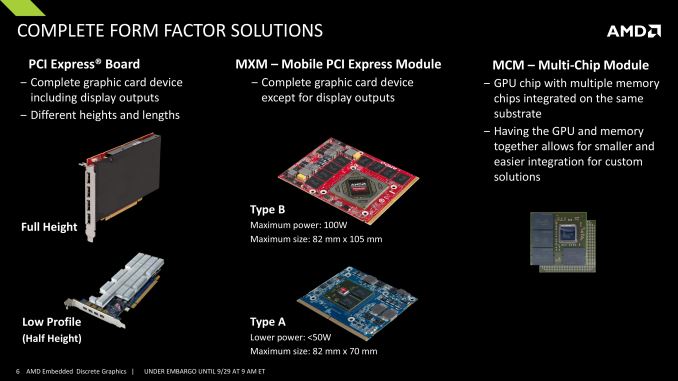
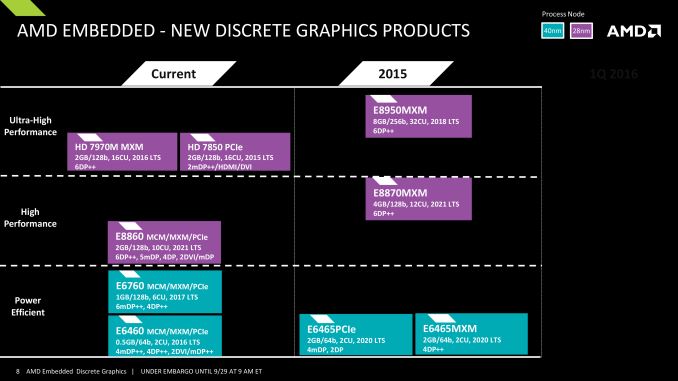
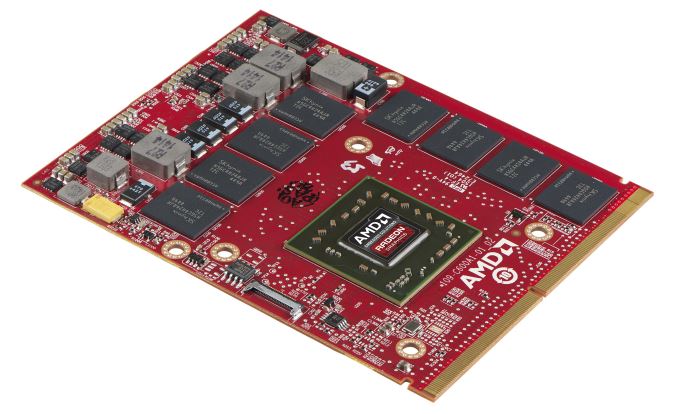
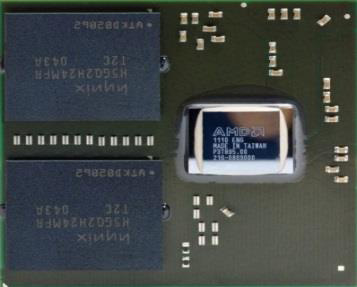
















Bookmarks